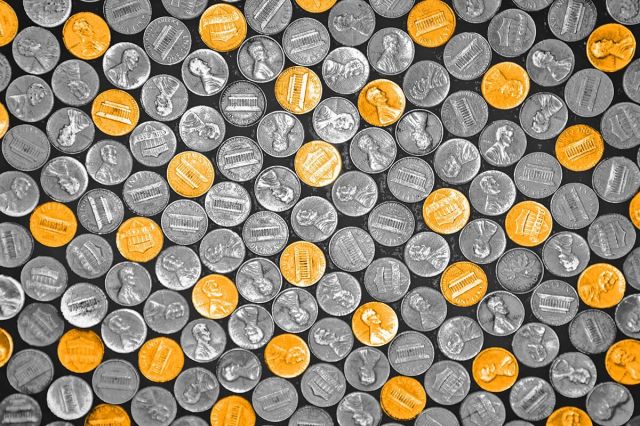
Benjamin Franklin Designed the First Penny
Long before Abraham Lincoln’s portrait graced the face of the one-cent piece, founding father Benjamin Franklin reportedly conceived of an early coin design now known as the “Fugio” penny. Franklin’s concept was first approved and manufactured under the watchful eye of the Congress of the Confederation in 1787, predating the U.S. Mint’s production by several years. The Fugio penny’s obverse depicts a sun and sundial accompanied by the Latin word “fugio” (translating to “I fly”), as well as the phrase “Mind Your Business.” On its other side, the reverse, the cent features the words “We Are One,” surrounded by 13 chain links to represent the original 13 colonies. All told, U.S. pennies have featured 11 different designs throughout history.

Abraham Lincoln Was the First Real Person To Appear on a U.S. Coin
Speaking of redesigns, it was in 1909 that the penny underwent a visual change that remains constant to this day. From 1859 to 1909, the U.S. penny depicted the silhouette of a fictitious Native American person. In 1909, President Theodore Roosevelt decided to celebrate Abraham Lincoln’s 100th birthday by changing the coin’s design to feature Lincoln’s face — making Lincoln the first real person to appear on U.S. coinage. To create the design, Roosevelt enlisted the acclaimed medalist Victor David Brenner, who designed the portrait of Lincoln that now appears on all pennies. George Washington would later appear on the quarter, beginning in 1932; Thomas Jefferson was added to the face of the nickel in 1938; and FDR showed up on dimes beginning in 1946.

Pennies Cost More To Make Than They’re Worth
Despite their storied history, pennies may not be around for much longer, due to the fact that they’re so expensive to make. The manufacturing cost for a penny is more than double its value — in 2021, each penny cost 2.1 cents to strike. That same year, the government produced 7.6 billion pennies, equating to a financial loss of $145.8 million. Part of the reason for this financial conundrum is that pennies are composed of 97.5% zinc and 2.5% copper, two metals that have recently dramatically risen in price. Several movements have begun in support of eliminating the coin from circulation, which is something America’s neighbors to the north chose to do with their own penny all the way back in 2012.
More Interesting Reads

The Most Valuable Penny Sold for $1.7 Million
Not all pennies are massive money drains. In fact, one penny sold at auction in 2010 for a whopping $1.7 million. The one-of-a-kind coin was accidentally struck in 1943, using a leftover bronze coin disc from 1942 at a time when the government was experimenting with other materials so they could preserve copper for wartime efforts in World War II. The auctioned coin is the only one known to have been mistakenly cast in bronze at the Denver Mint, making it exceedingly rare, though an additional 20 Lincoln pennies were believed to have been struck in bronze at the Philadelphia and San Francisco Mints. Throughout World War II, zinc-coated steel was ultimately used for pennies as part of the aforementioned conservation efforts.

The Penny Isn’t the Lowest-Value U.S. Coin Ever Produced
From 1793 to 1857, the penny held the distinction of being the second least-valuable American coin, since the U.S. Mint produced a half-cent coin during that time period. The first half-cent depicted Lady Liberty on its face, though subsequent redesigns would alter her appearance as well as the way she was facing. The half-cent was ultimately discontinued due to its perceived worthlessness at the time — though it would be worth 14 cents today when adjusted for inflation, making it more valuable than several modern coins still in circulation. From a collector’s standpoint, the half-cent is even more valuable, with lower-quality examples selling for $40, whereas some uncirculated half-cents are valued at up to $100,000.

Pressed Penny Collectors Are Known as Exonumists
Exonumia are tokens and other items that resemble money but aren’t meant to be used in circulation. One of the more popular hobbies related to exonumia is the collection of elongated or pressed pennies, the concept of which made its stateside debut at the Chicago World’s Fair of 1893. Though the inventor of the machine remains a mystery, more than two dozen designs were presented at the fair. Pressed pennies can now be found at festivals and amusement parks around the country, including at Disneyland, where you can press over 150 collectible designs onto your penny. While pressing pennies is perfectly legal in the United States, the act is actually forbidden in Canada, because the Canadian Currency Act forbids using coins for any purpose other than currency. (Although penny-pressing machines do exist in Canada, at least some use a zinc American penny instead of a Canadian coin.)












